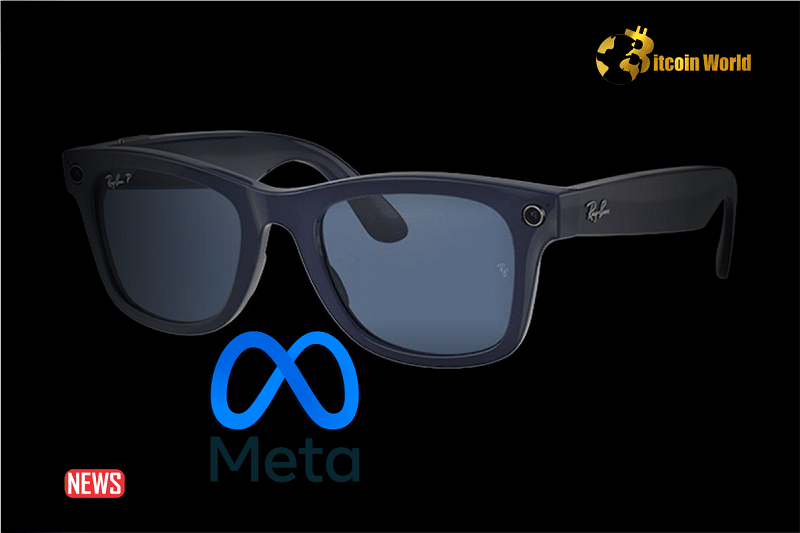[ad_1]
- Meta has introduced multimodal AI to Ray-Ban smart glasses to enhance user interaction with the environment.
- However, challenges in AI wearables’ user experience must be addressed for widespread adoption.
Meta has announced a significant enhancement to their Ray-Ban smart glasses, introducing a suite of multimodal artificial intelligence features that aim to provide users with innovative ways to interact with and understand their surroundings.
This upgrade leverages the glasses’ capabilities to process environmental data through integrated cameras and microphones, offering users contextual information based on their immediate environment.
Interactive AI Features Revolutionize Ray-Ban Smart Glasses
The centerpiece of this upgrade is the glasses’ ability to process environmental data and respond to user queries through interactive AI.
To activate this feature, users simply utter the voice command, “Hey Meta, take a look at this,” followed by their specific question or request.
For instance, a user might inquire, “Hey Meta, take a look at this plate of food and tell me what ingredients were used.” In response, the glasses capture an image and employ generative AI to analyze and identify the various elements within the frame.
When users pose questions about their visual surroundings, the Ray-Ban smart glasses capture a photo and transmit it to Meta’s cloud for processing.
Subsequently, the AI delivers an audio response directly through the glasses.
Furthermore, users can review their requests, the corresponding images, and the AI’s responses through the Meta View phone app, which pairs seamlessly with the smart glasses.
While these advanced features are currently being rolled out to a limited number of users via an early access program, Meta has ambitious plans to make them available to all users in the coming year.
See Also: Reebok Develops Blockchain-Based Virtual Gaming Experiences With Futureverse
Challenges In The AI Wearable Sector
Despite the innovative strides made in the AI wearable sector, significant challenges still need to be overcome in terms of user experience.
While these devices offer enhanced utility in specific aspects of life, they often introduce complications in other areas.
One example is the Humane AI pin, introduced earlier this year by former Apple employees. This screen-less AI device boasts a futuristic design but raises questions about its practicality due to its complexity and the numerous steps required to perform even basic tasks.
The challenge of finding practical use cases is not unique to the Humane AI Pin. It is a broader issue faced by many AI wearables.
Even the Meta Ray-Ban smart glasses, with their multimodal AI capabilities, may encounter this obstacle.
Although these glasses promise enhanced utility, particularly in private settings, the prospect of using them in public settings could be awkward and uncomfortable.
For instance, envision standing in line at a farmers market and asking your glasses to identify an exotic fruit or vegetable instead of simply inquiring with the vendor.
Engaging with a device using voice commands in public remains unfamiliar and uncomfortable for many people, highlighting the social discomfort associated with voice-command AI wearables.
Addressing these challenges is essential for the future success and acceptance of such devices.
See Also: AMD Launches Instinct MI300 Series To Compete In The AI Accelerator Market
The Future Of AI Wearables
AI wearables represent an emerging market with ongoing innovations in the artificial intelligence space. However, numerous obstacles must be surmounted for mass adoption to occur.
A critical challenge for the industry is the identification and establishment of practical use cases that can persuade consumers and businesses to transition from existing alternatives to AI wearable products.
The key to widespread acceptance and success lies in developing devices that seamlessly integrate advanced AI capabilities while addressing real-world needs in a user-friendly manner.
The industry must focus on creating wearables that seamlessly blend into daily life, offering tangible benefits without adding complexity or discomfort, particularly in social settings. Achieving this delicate balance will be crucial for the industry’s success.
Meta’s latest upgrade to the Ray-Ban smart glasses marks a significant step forward in the realm of AI wearables. The integration of multimodal AI features offers users exciting new ways to engage with their environment.
Nevertheless, challenges persist in the AI wearable sector, primarily related to user experience and practicality.
The industry’s future hinges on its ability to create devices that seamlessly integrate AI capabilities into everyday life without introducing unnecessary complexity or discomfort, ultimately driving widespread adoption and success.
[ad_2]
Source link






